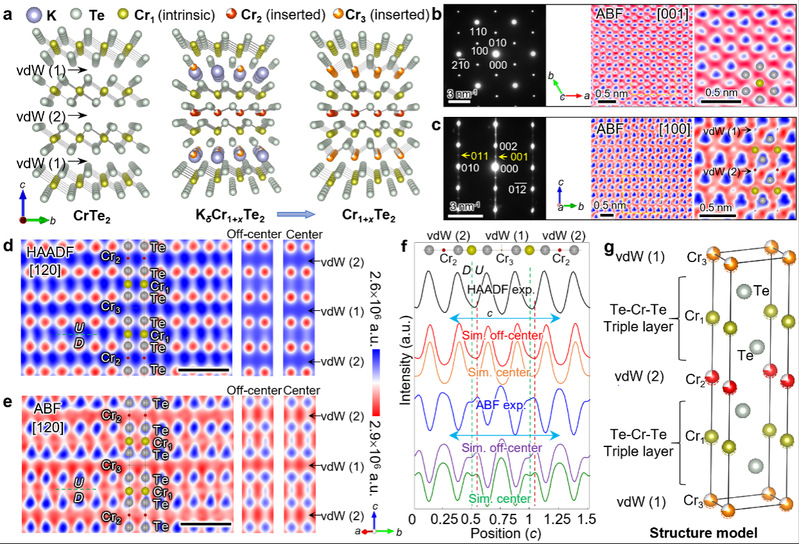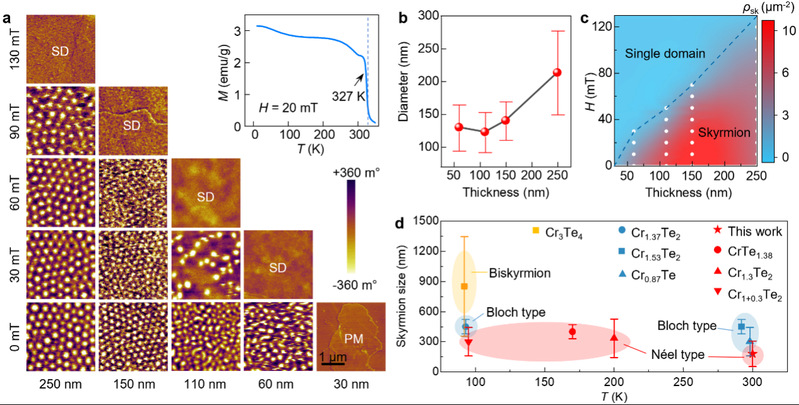Nankai University Research Team Makes Breakthrough in Room-Temperature 2D Topological Magnetic Materials Design
A research team has achieved a major breakthrough in the design and development of room-temperature two-dimensional (2D) vdW topological magnetic materials. Their findings appear in the paper titled “Intercalation-Engineered Out-of-Plane Polarized van der Waals Ferromagnetic Superlattice with Room-Temperature Néel-Type Skyrmion”, published in ACS Nano on September 4, 2025. The work was led by Professor Xuewen Fu from the Ultrafast Electron Microscopy Laboratory at the School of Physics, Nankai University, in collaboration with research groups headed by Professor Zhipeng Hou from South China Normal University, Professor Yimei Zhu from Brookhaven National Laboratory, Professor Bin Xiang from University of Science and Technology of China, and Associate Researcher Xi Shen from Institute of Physics, Chinese Academy of Sciences.
The researchers proposed a “two-step intercalation–de-embedding” approach to engineer and realize a one-dimensional out-of-plane polarized superlattice in the Cr-based binary 2D vdW magnets. This unique structure breaks the spatial inversion symmetry along the c-axis, inducing a pronounced Dzyaloshinskii–Moriya interaction (DMI), thereby enabling the formation of high-density Néel-type magnetic skyrmions. By tuning the Cr intercalation ratio, the team realized, for the first time, room-temperature, high tensity Néel-type skyrmions with sub-100 nm dimensions in a binary compound, paving the way for low-power, high-density 2D topological spintronic devices.
Last year, the team introduced Fe3-xGaTe2 as the first ternary 2D topological magnetic material capable of hosting room-temperature, sub-100 nm skyrmions. This was achieved by breaking mirror inversion symmetry in the centrosymmetric Fe3GaTe2 through introduce asymmetric Fe(I) vacancies, leading to Fe(II) atomic displacements and structural polarization (Nature Communications 15, 1017 (2024)). Building on that work, the present study employs a two-step intercalation–de-embedding method to engineer a self-intercalated binary 2D magnetic material, Cr1+xTe2, with out-of-plane polarized superlattice structures. Distinct from all previously reported Cr1+xTe2 compounds, the version synthesized by this method exhibits 2![]() superlattice modulation exclusively along the c-axis, thereby breaking spatial inversion symmetry and enabling high-density Néel-type skyrmions via a pronounced DMI. Notably, the method offers strong tunability of the atomic intercalation ratios. By carefully adjusting the Cr intercalation level, the team realized, for the first time, room-temperature high-density Néel-type skyrmions with sub-100 nm size in a binary compound, with the smallest size reaching 80 nm. This remarkable room-temperature skyrmion performance establishes Cr1+xTe2 as a highly promising binary 2D topological magnetic material platform for next-generation low-power, high-density topological spintronic devices.
superlattice modulation exclusively along the c-axis, thereby breaking spatial inversion symmetry and enabling high-density Néel-type skyrmions via a pronounced DMI. Notably, the method offers strong tunability of the atomic intercalation ratios. By carefully adjusting the Cr intercalation level, the team realized, for the first time, room-temperature high-density Néel-type skyrmions with sub-100 nm size in a binary compound, with the smallest size reaching 80 nm. This remarkable room-temperature skyrmion performance establishes Cr1+xTe2 as a highly promising binary 2D topological magnetic material platform for next-generation low-power, high-density topological spintronic devices.

Fig. 1. Structure characterization of the as-synthesized Cr1.5Te2.

Fig. 2. Sample-thickness- and magnetic-field-dependent room temperature Néel-type skyrmions in Cr1.4Te2.
Nankai University serves as the primary affiliation and corresponding institution for this work. The co-first authors are Ying Deng (Ph.D. candidate at Nankai University), Zefang Li (postdoctoral researcher at Nankai University), Guanqi Li (lecturer at Guangdong University of Technology), and Xi Shen (associate researcher at Institute of Physics, Chinese Academy of Sciences). Corresponding authors are Professor Bin Xiang (University of Science and Technology of China), Professor Zhipeng Hou (South China Normal University), Professor Yimei Zhu (Brookhaven National Laboratory), and Professor Xuewen Fu (Nankai University).
Full Paper Available at: https://pubs.acs.org/doi/full/10.1021/acsnano.5c10466
(Edited and translated by Nankai News Team.)









